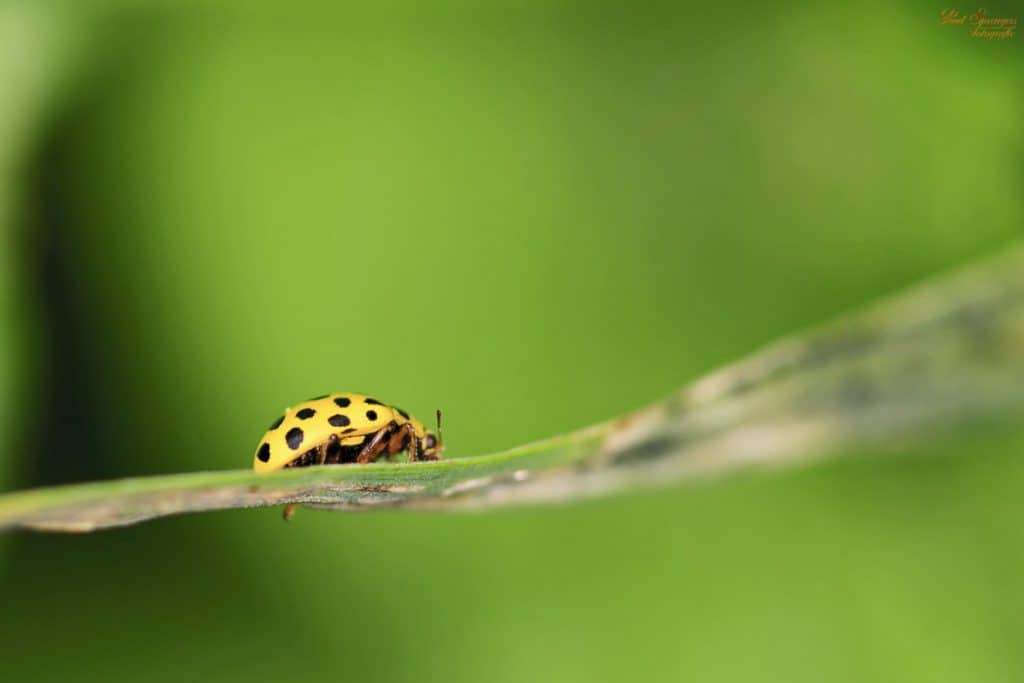
If you enjoy reading this article, why not check out our article on What Can Ladybugs Damage? The surprising answer
The Meanings of the Colors of Ladybugs
When I was a kid, the ladybugs in the backyard were red, docile and friendly. However, a new orange ladybug was introduced to help control another pest. These orange ones were actually aggressive and would pinch for any reason. As a few years went by, the red ones started coming back and it had me wondering.
How many colors do ladybugs come in and what are the differences between them?
Ladybugs are commonly described as red and black insects. And this is how they are almost always depicted. However, red is definitely not the only color ladybugs come in!
On the contrary, they come in a variety of other colors too such as
Their colors indicate their toxicity level to defend themselves from their enemies.
We’ll also talk about some ladybug colors that might not be real:
Click on the color that interests you or keep reading to find out why ladybugs are so colorful.
Why Are Ladybugs So Colorful?
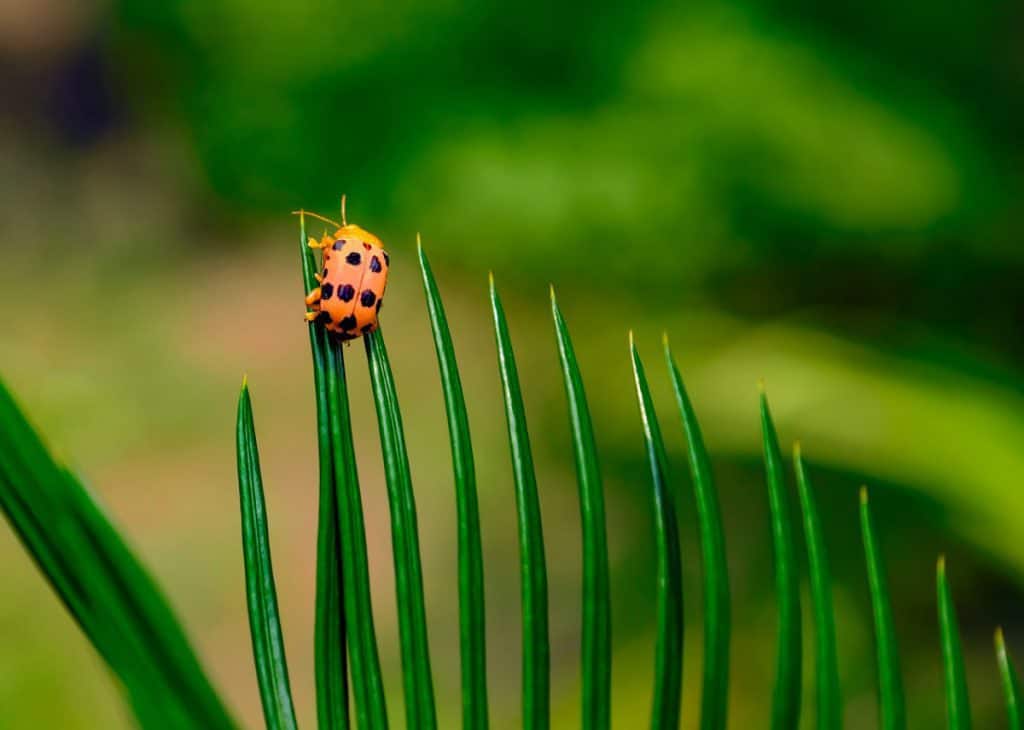
There are 6000 different species of ladybugs recorded worldwide.
They come in different sizes ranging from 0.03 to 0.71 inches. Often they are colored yellow, orange or red with black dots on their backs.
However, they come in a multitude of colors depending on their species.
In this article, you will learn about the various colors of ladybugs and species that are specific to these colors. If you are interested in learning more about the topic, we also talk about how ladybugs’ vibrant colors can be warning signs to predators in our article What Are Boy/Male Ladybugs Called?
The Reason Behind The Rainbow of Ladybugs
The ladybug’s colors are a survival adaptation that frequently encourages their enemies to stay away. The ladybug’s color denotes its toxicity to predators. The brighter and more vibrant the color, the more toxic the smell and taste is for its enemies.
But, it’s hard to deny, the variety of bright colors is what makes ladybugs pretty to the human eye! If you’ve found a ladybug with a peculiar color, and are wondering if it truly is a ladybug, keep reading. We’ll cover all the commonly seen types of ladybugs:
The Group Of Yellow Ladybugs
Can ladybugs be yellow? Yes! Yellow is actually quite a common color among ladybirds. It’s not even only one species that is yellow – but a few of them.
The design and color of ladybugs have been changing for years. The different strains in changing colors and designs largely mix with their habitats, potential danger, and climates.
If you see a yellow ladybug, the black spots on its back will let you determine which species it is.
Here are three different types of yellow ladybugs and their description as well as where they can be found:
- 14 Spotted Lady Beetle
- 22 Spotted Lady Beetle
- 16 Spotted Lady Beetle
For more about this topic, check out my article dedicated to yellow ladybugs only.
14-Spot Ladybug
How to identify?
The 14 spotted ladybugs are known as Propylea Quatuordecimpunctata. These ladybirds have up to 14 black spots on their backs, but sometimes they can have fewer spots. Therefore, if a ladybug is yellow and has up to 14 spots, then it’s most likely a 14-spot ladybird.
Occasionally, the black spots ‘melt’ into their yellow color background which sometimes creates an anchor on their Elytra.
There are also times where the spots can almost be rectangular and can resemble a checkerboard.
The yellow ladybug lives in different habitats such as forests, woodlands, and meadows. Just like any other ladybugs, they are omnivores and eat different types of food.
Where is it found?
You can find the yellow ladybugs across Europe, North Africa and almost all of Asia, stretching up to the Arctic boundaries and through to the far east.
For more information about different types of ladybugs, check out Can You Keep Ladybugs As Pets?
22-Spot Ladybug
How to identify?
How many spots can a 22 spotted ladybird have?
The 22 spotted ladybugs are also known as the Psyllobora Vigintimaculata. As the name indicates, this type of ladybug has 22 spots on their backs.
The 22 spotted ladybugs are typically small measuring 0.11 to 0.18 inches in length. They have a bright yellow back with 22 distinctively round black spots.
Where is it found?
This type of yellow ladybug can be found in grasslands, gardens, as well as towns, and parks. They usually feed on mildew and they love hogweeds. These yellow ladybugs can be found in the West part of the world.
It can be found across North America, Alaska, Canada, and Mexico. However, it is more common to find them in England, Western Asia, and some parts of the Middle East.
16-Spot Ladybug
How to identify?
Just like the 14-spot ladybug, the 16-spot ladybugs have black spots down where the wings meet along the centerline. Sometimes their spots melt together and it forms a line along each of their sides.
Have you ever wondered if ladybug spots tell their age? Find out by reading Do Ladybug Spots Tell Their Age?
Where is it found?
The 16-spot ladybugs can be found in sand and dunes type of areas as well as grasslands.
They can also be found in dry or even marshy meadows during the warmer times of the year. This species of ladybug feeds on pollen, nectar, and fungi. It has also been known that they feed on mites, thrips, and aphids.
During Winter, these types of species can gather in large numbers around trees and other woods such as posts, fences or logs during their hibernation. They can be found across Europe, East, and West Asia, as well as the far East and some parts of the Middle East.
Seeing a yellow ladybug signals adventure and travels to different or far places. It is also a sign of love or a new chapter in your life.
Can Ladybugs Be Orange?
Halyzia Sedecimguttata: Orange Ladybugs
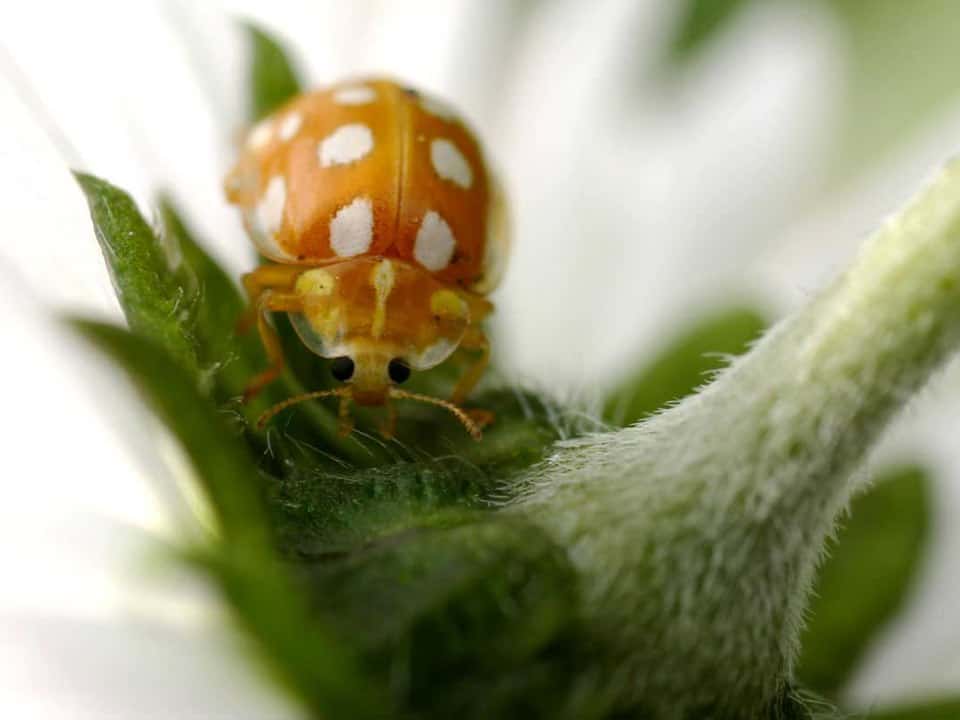
How to identify?
Orange ladybugs are known as the Halyzia Sedecimguttata. The orange ladybugs have cream spots on their back. They usually have 14 to 16 cream spots that run along their backs. They are usually oval-shaped with 0.19 – 0.20 inches measured in length.
Aside from their cream spot on their backs, they also have orange-colored spots on their head covering which is called the pronotum.
One distinctive thing about the orange ladybug is that it has transparent edges on its body. This helps them blend with their surroundings in their habitat area.
Where is it found?
The orange ladybugs are commonly found in Europe and they are increasing in numbers. They feed on powdery white mildew that forms on surfaces of leaves. An adult orange ladybug, however, infests on trees and bushes, and occasionally they may feed on aphids as well.
In the past, the orange ladybugs are known to feed off of ancient woodland but they eventually adapted to feed on Sycamore and Ash.
Just like any other ladybugs, if they land on you it is believed that you will have good luck in your life.
Can Ladybugs Be Black?
Harmonia Axyridis: Black Ladybugs
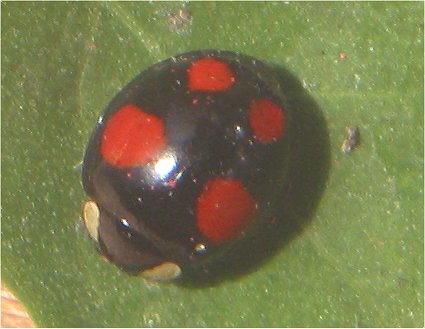
How to identify?
Black ladybugs are part of the multicolored group of ladybugs called the Harlequin ladybirds and Harmonia Axyridis.
These types of ladybugs are one of the most invasive insects in the world. They were first imported from Asia to North America around the 1980s in order to control aphids that were feeding on plants.
Unlike other ladybugs who stick to eating aphids, the Harlequin ladybirds do not stick to one food. Once these types of ladybugs finished eating aphids, they would move on to other ladybird’s eggs and larvae. They even feed on moths and butterflies’ eggs and caterpillars.
These black ladybugs pose a threat to other ladybug species since they have such an appetite. They can easily eat all of the food of other ladybugs that feed on aphids. This is the main reason why the two spot ladybugs are scarce.
Are black ladybugs poisonous?
They may not be dangerous to humans, however, during the Winter season they tend to hibernate in houses and other buildings. There are many cases that people find a whole lot of black ladybugs in their homes. When Spring comes around, they find their way out of the building and houses to become active again.
Where is it found?
The black ladybugs are now established in North America, Europe, Africa, and across South America. Just like any other ladybugs, black ladybugs are a symbol of fortune and prosperity.
Can Ladybugs Be Grey?
Olla v-nigrum: The Grey Ladybug
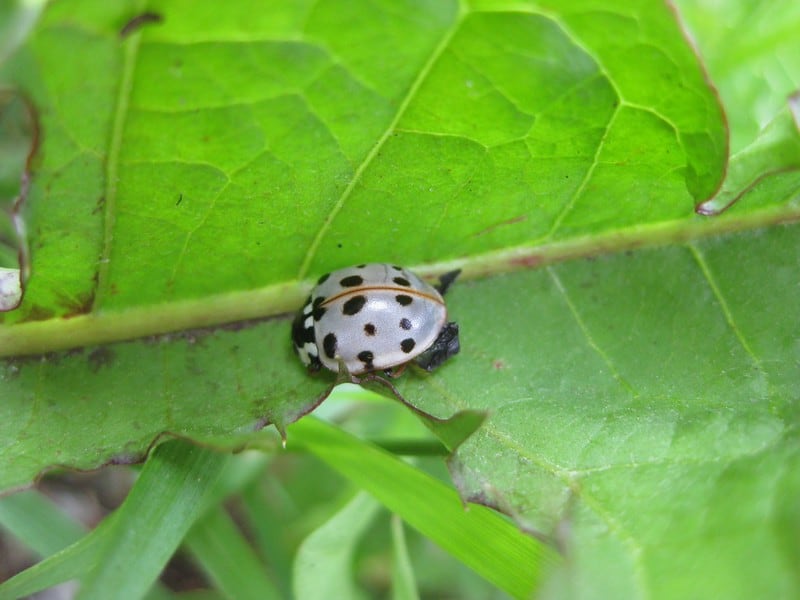
These are known as the Ashy Grey Lady Beetle and they can have from two to fifteen black spots. They are usually found in the North America region. They are also believed to be seen in some parts of South America.
These Ashy Grey Lady Beetle also comes in another color which is all black with two red spots. This black red ladybug is called ‘twice stabbed lady beetle’ because of the two red spots on its back that looks like wounds.
Now, these types of ladybugs bite whenever they feel threatened by humans. They will also bite you if they mistake your warm hand for a soft-bodied insect. However, their bites are not harmful to humans. This would only cause irritation and a bit of itching. If you do have a severe or an allergic reaction, it is best to see your doctor.
Just like your ordinary ladybugs, they also feed on aphids in their daily lives. The grey colored ladybug is believed to bring happiness, awareness, and prosperity into your life.
Can Ladybugs Be Blue?
Halmus Chalybeus: Blue Ladybugs
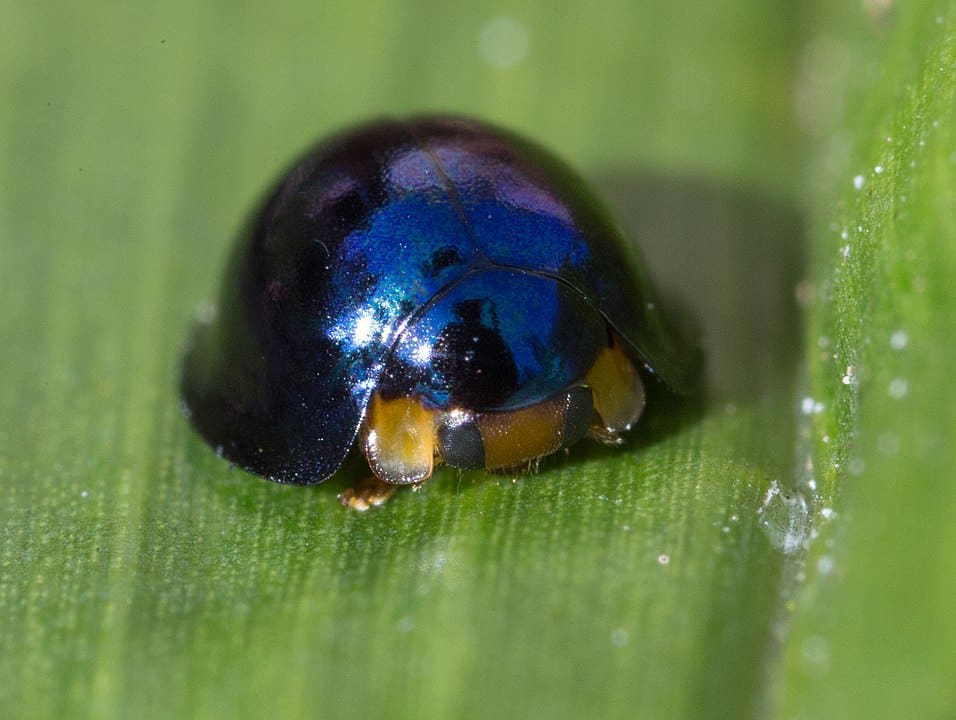
Where it is found?
These blue ladybugs are also known as the Halmus Chalybeus. They can be found in Australia and New Zealand. They are usually described as blue-green or blue metallic with translucent around the edges. They are commonly found in backyards, orchards, fields, and parks.
The Steel blue ladybugs have the main distinction between male and female species, unlike your ordinary ladybugs, it is hard to tell. The male minor has an orange color in the head area. Where the female is the same color throughout their body.
Both males and females do not have any spots on their backs. However, their shells are the same as the regular ladybugs. These species feed on lice, scale insects, and moth eggs. The Steel Blue ladybugs hibernate from May to September.
During this time, they are known to gather in groups under tree bark and other areas to shelter from the cold weather. They usually come out during Spring and they are set to find food as well as mate with other ladybugs.
Unlike the other color of ladybugs, the Steel Blue ladybugs have the same meaning as any other ladybugs. They symbolize love, luck, and prosperity.
Mythical Ladybugs
The Myth of Purple Ladybugs
While there were rumors about purple ladybugs, there are no official findings that would confirm they exist.
The buzz about purple ladybugs started in March 2015 and quickly spread around the internet. Here is how it happened:
There was a Facebook page called Discovering Our Wonderful World. They stated that there were purple ladybugs, and that they have 15 spots on their backs. It was also stated on the page that it was only found in Hawaii. They did show pictures of purple ladybugs, however, there are reasons to suspect the photos have been edited. This page no longer exists on Facebook.
The fifteen spotted ladybug that they were talking about was originally colored red or orange with black spots. However, we never know what nature can bring us. There may be a time in the future where purple ladybugs do exist.
As of now, this story is false and it has not been proven scientifically that they exist.
Can Ladybugs Be Green? – Some Ladybugs Have a Green Phase
There are no green ladybugs that exist within the ladybug family. However, a ladybug that is in its pupa stage may not have its final identifying colors and often does not have any spots yet. In the right setting, the pupa might have appeared in very pale green.
Green ladybugs in this form do not have any spots, and they will change their appearance very quickly. The color green on ladybugs usually only lasts for about 24 hours. Once the shell has dried and hardened into its natural color it will be permanent throughout their lifespan. This time the spots will appear on their backs.
If you happen to see a ladybug that appears green, it might be that it is in this pupal stage.
But it could also be the green beetle. The green beetle is often mistaken for a green ladybug. They are a little bit similar to the shape and size of ladybugs.
Gold-Like Colors of Ladybugs
The gold color is another one that does not exist when it comes to ladybugs. These types of insects are called the golden tortoise beetle. They come in different colors such as reddish-brown, gold, and metallic with black spots. This is where the ‘goldbug’ nickname comes from.
They are often mistaken for ladybugs because of their body structure and size. They can also be found munching on plants throughout the world. These beetles are common in North America and can be often found in backyards that have plants such as sweet potatoes and morning glory.
Also, these beetles are not always golden. They change colors throughout the seasons and even depending on their mood. They have a transparent shell and the liquid that is beneath the shell is the one that changes colors. If the golden beetle feels threatened it will release a toxic liquid.
Conclusion
Ladybugs have different numbers of species and to determine their species it is based on their color. Some colors that ladybugs come in are yellow, orange, black, grey, and blue. There are misconceptions that purple and green ladybugs exist.
However, it has not been scientifically proven that they exist. Most of the species consist of black spots that are placed on the ladybug’s back. Each ladybug species can be found in different locations. Some ladybugs bite if they feel threatened, such as the Ash Grey Lady Beetle.
If you are planning to take care of ladybugs, knowing their colors would be great. It will help you determine the food that they eat as well as their behavior.
If you enjoyed reading this article, why not check out our articles on What Are Boy/Male Ladybugs Called? and What Can Ladybugs Damage? The surprising answer
If you enjoyed reading this article, then please share it out on social media. It helps promote the site and keeps me motivated to produce the best articles I can.
All the best
Steve
ps If you’re interested in reading more about the color of insects, why not check out our Color of Beetles article
Recent Posts
Tiny Black Bugs in Bathroom NO WINGS: What They Are and What to Do!
Finding tiny black bugs in your bathroom can be uncomfortable, to say the least. Especially if they are persistent, or they appear in very large numbers, which they often like to do. When it...
Tiny Black Bugs in Plant Soil - What Are They & What To Do About It
A short horror story: You get a new houseplant. You do your best to take care of it. You’ve ensured that it has the right soil, the right amount of sun, it gets enough water. And then one day, you...

